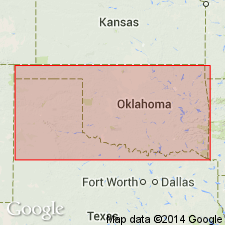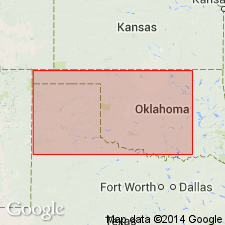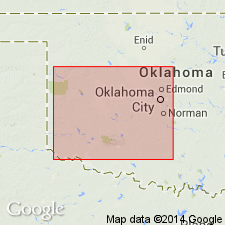
- Usage in publication:
-
- Greer division
- Modifications:
-
- Named
- Dominant lithology:
-
- Clay
- Shale
- Sandstone
- Gypsum
- Limestone
- AAPG geologic province:
-
- South Oklahoma folded belt
Summary:
Consists of red clay, shale and sandstone with interbedded gypsum and magnesian limestone. Is 150 to 300 feet thick. Divisible into several gypsum and dolomite beds; named beds are (ascending order) Chaney, Kiser, Haystack, Cedartop, and Collingsworth gypsums, and Delphi dolomite at the top. The gypsum and dolomite beds form ledges 4 to 100+ feet thick. They are separated from each other by the clastic rocks. Overlies the newly named Woodward division. Underlies the Quartermaster division. Age is Permian.
Named for a county in southwest OK, [South Oklahoma folded belt province]. Type locality not designated.
Source: Modified from GNU records (USGS DDS-6; Denver GNULEX).

- Usage in publication:
-
- Greer formation*
- Modifications:
-
- Revised
- AAPG geologic province:
-
- Anadarko basin
- South Oklahoma folded belt
Summary:
Is a Permian unit 150 to 300 feet thick composed of red clay, shale, and sandstone intercalated with beds of gypsum. Northernmost outcrop is in southeast Woodward County, Oklahoma. In western part of area, rocks of Greer are more evenly bedded; sandstones are nearly absent. In eastern part of area, Greer is chiefly red shale interstratified locally with red sandstone and gypsum. Gypsum members [separated by clastics] are (in decreasing age) Chaney, Kiser, Haystack, Cedartop, and Collingsworth. Upper contact of Greer placed at the top of a thin 1 to 5 feet-thick dolomite, the Mangum dolomite member (new). Ten miles south of Mangum, the Mangum dolomite rests on red and blue clay. Report includes columnar section. Geologic map shows Greer formation in west Oklahoma, in the Anadarko basin and in the South Oklahoma folded belt province.
Source: Modified from GNU records (USGS DDS-6; Denver GNULEX).

- Usage in publication:
-
- Greer formation†
- Modifications:
-
- Abandoned
Summary:
The Greer formation is here abandoned. For the so-called "eastern area" of the Greer, the name Cloud Chief formation is proposed. It is shown that the rocks in the "western area" of the Greer belong to Blaine, Dog Creek, Whitehorse, and Cloud Chief [Chaney, Kaiser, Haystack, Cedartop, Collingsworth, and Mangum, formerly members of the Greer, are presumably also abandoned.] The report area, in southwestern Oklahoma, includes all or parts of 10 counties east, northeast, north, northwest and west of the Wichita Mountains, [S. Oklahoma folded belt province and Anadarko basin]. The new classification of the Permian of this area is as follows (ascending): Duncan sandstone (new), Chickasha formation (new), Blaine gypsum (revised), Dog Creek shale (rank raised), Whitehorse sandstone (revised), Day Creek dolomite (revised), Cloud Chief formation (new), and Quartermaster formation. All of these units are stratigraphic equivalents of the Double Mountain, the uppermost Permian division of Texas. Age is Permian. Report includes geologic map.
Source: Modified from GNU records (USGS DDS-6; Denver GNULEX).
For more information, please contact Nancy Stamm, Geologic Names Committee Secretary.
Asterisk (*) indicates published by U.S. Geological Survey authors.
"No current usage" (†) implies that a name has been abandoned or has fallen into disuse. Former usage and, if known, replacement name given in parentheses ( ).
Slash (/) indicates name conflicts with nomenclatural guidelines (CSN, 1933; ACSN, 1961, 1970; NACSN, 1983, 2005, 2021). May be explained within brackets ([ ]).

